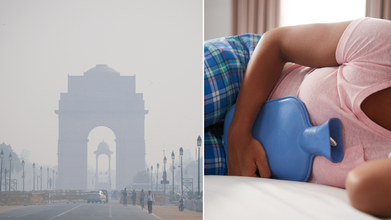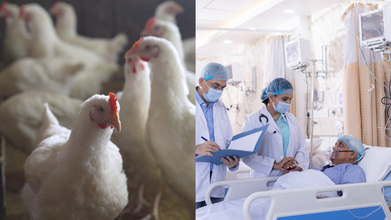- Health Conditions A-Z
- Health & Wellness
- Nutrition
- Fitness
- Health News
- Ayurveda
- Videos
- Medicine A-Z
- Parenting
Getting At Least 5,000 Steps A Day Could Help You Tackle Depression

Walking (Credit: Canva)
Walking is more than just a way to move from point A to point B—it may be a simple yet powerful way to boost your mental health. While it is constantly known to impact your physical well-being, research has found that it can also help you tackle depression. According to the study, adults walking 5,000 or more steps daily experienced fewer depression symptoms compared to those who walked less. Mental Health benefits increased with more steps. For instance, research participants, who walked over for at least 7,500 steps every day saw a 42% reduction in depression symptoms.
Interestingly, even a modest boost in daily steps made a difference. Adding just 1,000 extra steps daily was linked to a lower risk of depression. Another analysis from the same study highlighted that people who hit 7,000 steps or more each day were less likely to develop depression than those who walked less. Experts have said that walking may reliably reduce depression by measurable amounts while also potentially lowering the risk of developing depression.
For their research, experts reviewed data from 33 studies involving over 96,000 adults to explore the link between walking and reduced depression symptoms. The studies used wearable devices like pedometers and smartphones to measure participants' step counts, typically over a week. The meta-analysis found that walking not only reduced depression symptoms but also served as a practical, low-pressure alternative to structured exercise, especially for those who might find more intensive workouts intimidating.
However, the researchers acknowledged some limitations. People who walked more might already feel better, and the study didn’t explore other factors, such as the potential benefits of walking in nature or with others, which could further improve mood.
How Many Steps Should You Walk Everyday?
According to health experts, you should start small with achievable goals of 1,000 to 2,000 steps daily. It should then be gradually increased by 500 steps. Integrating walking into daily routines—such as taking the stairs, parking further away, or enjoying a short post-meal stroll—can help make the habit sustainable. Walking does not require special equipment, a gym membership, or advanced fitness knowledge, making it an inclusive activity.ALSO READ: Feeling Festive Depressed? There's Now Help Available For You
How Common Is Depression?
According to the American Psychiatric Association (APA), depression is a mental disorder that can be characterized by persistent depressed mood for most of the day, for more days than not, for at least two years. In children and adolescents, the mood can be irritable or depressed and must continue for at least one year. Other symptoms include poor appetite or over eating, fatigue, low energy, sleeplessness, poor concentration amongst others. Depression can affect all aspects of life, including relationships, school, and work. While walking offers measurable mental health benefits, individuals with depression may need a more comprehensive approach. Combining walking with standard treatments, such as antidepressants and therapy, could yield the best results.ALSO READ: Can You Rewire Your Brain? 6 Ways To Do It
Is Delhi's Toxic Air Making Your Period Cramps More Painful? Here's What Study Says

Credits: iStock
Air quality in Delhi remains toxic, despite the GRAP !V measures implemented in the national capital. Today, Delhi recorded an AQI of 358, this remains under 'very poor'. As per the Central Pollution Control Board (CPCB), the AQI was recorded at 442 in Ghazipur, 409 in ITO, and 447 in Palam, all under 'severe' category.
While we have long known that pollution impacts lung and respiratory health, but it can impact beyond that, including causing severe menstrual cramps.
What Proves That Air Pollution Impacts Menstrual Cramps?
A study published in Frontiers in Public Health, explored the data of 2,96,078 women and girls between the age of 16 to 55 years in Taiwan and correlated it with the long-term air pollution data between 2000 and 2013. None of these women had any history of dysmenorrhea before the survey had began. Dysmenorrhea is a common gynaecological condition that impacts 16 to 91% of people in their reproductive age. The signs and symptoms include painful and severe periods that are results of hormonal imbalances.
The results showed that during the 13 years, 4.2% women and girls were diagnosed with dysmenorrhea for the first time. The study concluded that risk of developing dysmenorrhea was up to 33 times higher among women and girls who lived in areas with the highest levels of air pollutants.
Professor Hsu, who conducted the study said, "Our results demonstrate the major impact of the quality of air on human health in general, here specifically on the risk of dysmenorrhea in women and girls."
The pollutants in questions are nitrogen oxide, nitric oxide, nitrogen dioxide, carbon monoxide, and particle smaller than 2.5 µm in diameter (PM2.5).
How Air Pollution Shapes Menstrual Health - Its Impact
The public health impact of air pollution is more layered and gendered than it often appears. Over the years, a growing body of research has begun to link polluted air with menstrual health problems. A 2018 study found that teenage girls exposed to higher air pollution were more likely to experience irregular periods and took longer to develop regular cycles during adolescence and early adulthood. Other studies have connected air pollution with longer menstrual cycles, increased stress, reproductive health issues, and even changes observed during lockdown periods. Conditions such as infertility, metabolic syndrome, and polycystic ovary syndrome have also been associated with prolonged exposure to polluted air.
These findings challenge the idea that menstrual health is purely biological. Instead, it is deeply influenced by social and environmental conditions, including income levels and where a person lives. In the present study, researchers observed that younger women, women from lower-income backgrounds, and those living in highly urbanised areas faced a higher risk of developing dysmenorrhea or painful periods. Among all factors studied, long-term exposure to high levels of PM2.5 emerged as the strongest contributor. PM2.5 refers to fine, inhalable particles commonly found in polluted air that can penetrate deep into the body.
The concern becomes sharper in the Indian context. In 2019, India recorded the highest PM2.5 levels globally. The study highlights clear differences in menstrual experiences between women and girls living in urban versus rural areas. Those in low-income and densely populated urban regions, where exposure to air pollution is often highest, showed a significantly greater risk of dysmenorrhea.
This health burden is further compounded by period poverty, which continues to affect large sections of rural India and many other countries. Limited access to sanitary products, lack of awareness, and social stigma mean that many girls and women already miss school and work during their periods. Increased menstrual pain linked to environmental factors like air pollution only deepens these challenges.
A 2017 study underlined the importance of identifying environmental influences on the menstrual cycle from a public health perspective, noting potential long-term consequences such as infertility, reproductive cancers, osteoporosis, and metabolic disorders.
Using An Air Purifier At Home? Pulmonologist Warns These 5 Common Mistakes Could Put Your Lungs At Risk

Credits: Canva
With winter setting in, Delhi and the NCR are once again dealing with a sharp rise in air pollution, with AQI levels often slipping into the “very unhealthy” category. Hazy mornings, dense smog, and a steady increase in breathing problems have made clean air feel out of reach for many residents. As a result, people are relying more on air purifiers indoors and masks outdoors.
Still, not everyone knows how to use these measures correctly. We spoke to pulmonologist Dr. Vijay Kumar Agrawal, Director of Pulmonology and Critical Care at Yatharth Super Speciality Hospital, Faridabad, who shared a few important points that can help protect your lungs even inside your home.
What Is An Air Purifier?
An air purifier is a device designed to improve indoor air quality by filtering out pollutants such as dust, pollen, pet hair, smoke, and mold spores. It works by pulling air through filters like HEPA or activated carbon, or by using certain technologies, and then releasing cleaner air back into the room.
This process can help reduce triggers for allergies and asthma and make breathing easier. While air purifiers are particularly helpful for people with respiratory conditions, growing pollution levels have made them a common household choice even among otherwise healthy individuals. That said, simply owning an air purifier is not enough. There are a few key things you should keep in mind while using one.
Select Air Purifier With HEPA Filter Only
Dr. Agrawal advises choosing an air purifier that uses a HEPA filter. Many people unknowingly use air purifier that release ozone or free radicals, which can increase the risk of breathing problems, irritation, coughing, and shortness of breath. According to him, “Air purifiers with HEPA filters are ozone-free and safer because they do not emit harmful particles or ozone into the air.”
Always Maintain An Ideal Indoor Humidity Level- 40-50%
To reduce the impact of viruses, indoor pollutants, and dryness on the body, it is best to maintain indoor relative humidity between about 40% and 60%. Dr. Agrawal explains that excessive use of air purifiers can lower humidity levels indoors, leading to dryness. “Low humidity can irritate the airways and may worsen respiratory issues,” he says.
Keep Your Air Purifier 2-6 ft Away From You
Experts recommend keeping an air purifier at a distance of around 2 to 6 feet from where you sit or sleep. Placing it within this range helps clean the air more effectively in your breathing zone, especially in spaces like bedrooms or offices. Dr. Agrawal notes, “Keeping the air purifier at an appropriate distance helps reduce PM2.5 and PM10 levels, along with other particles such as pollen, mold spores, and certain bacteria around us.”
Dont Burn Incense Sticks And Mosquito Coils With An Air Purifier In The Room
In many Indian households, burning incense sticks or mosquito coils indoors is common. However, these release chemical irritants that can be harmful to the lungs. Using them in the same room as an air purifier defeats the purpose of cleaner air and should be avoided.
Dont Tightly Close Windows And Doors
Proper ventilation is still important, even when using an air purifier. Dr. Agrawal recommends keeping at least one window or a small door slightly open to allow fresh air exchange. This helps ensure a supply of oxygen from outside and prevents indoor air from becoming stale.
Dr. Agrawal adds that while using an air purifier is generally safe and even long-term use is not harmful, following these precautions is essential to truly protect your lungs and maintain healthier air indoors.
Could Bird Flu Become The Next Pandemic For Humans?

Credits: iStock
Bird flu viruses have been present for long, and what was earlier understood as a virus just limited to avian, could now affect humans too. Bird flu viruses could have a potential risk for humans and may become next pandemic. This comes from two different studies, one done by the universities of Cambridge and Glasgow that show how avian flu strains are multiplying even when the body temperatures could hinder viruses. Whereas, another important study led by Indian scientists, by Philip Cherian and Gautam Menon of Ashoka University, published in BMC Public Health predict if H5N1 or the bird flu virus, could start spreading among humans. How quickly must we act to stop it?
How Was The Study Conducted?
Using BharatSim, an open-source simulation platform originally developed during Covid-19, the researchers recreated what an outbreak might look like in real life. “The threat of an H5N1 pandemic in humans is a genuine one,” Prof Menon said, “but we can hope to forestall it through better surveillance and a more nimble public-health response.”
Their model begins where experts believe a real outbreak would: with a single human infection, most likely a poultry worker or someone exposed to infected birds at a farm or market. The danger, the researchers argue, lies not in that first case, but in whether sustained human-to-human transmission takes hold.
The Cambridge and Glasgow study also provides that the viruses generally replicates most effectively in the upper respiratory tract, where temperatures are around 33 °C. They replicate less efficiently deeper in the lungs, where temperatures rise to about 37 °C. However, avian flu thrives in hotter environments, which can read up to 40 to 42 °C.
Why Does Timing Matter More Than Anything Else?
The study by Ashoka University has the most sobering findings in how fast control can slip away. According to the simulations, once cases rise beyond roughly two to ten people, the virus is likely to move beyond immediate contacts and into the wider community.
If households of close contacts are quarantined when just two cases are detected, the outbreak can almost certainly be contained. By the time ten cases are identified, however, the model suggests the infection has probably already spread far enough that early interventions no longer make a meaningful difference.
To ground their work in reality, the researchers focused on a village in Tamil Nadu’s Namakkal district, one of India’s largest poultry hubs. With more than 1,600 farms, around 70 million chickens and tens of millions of eggs produced daily, the region reflects the kind of dense human-animal interaction where spillovers are most likely.
In the simulation, the virus spreads outward from a single workplace into homes, schools and markets, tracking primary and secondary contacts. Once “tertiary” infections, contacts of contacts, appear, control becomes dramatically harder without severe measures such as lockdowns.
What Works And What Does Not Work
Culling birds work, but only if it happens before humans are infected. Once the spillover is done, isolating patients and quarantining is the only option that can stop the virus, that too if done very early. Targeted vaccination could help raise the threshold at which the virus can sustain itself. Quarantine imposed too early keeps families together longer, increasing household transmission. Imposed too late, it barely slows the outbreak at all.
Why Is It Important To Understand How Avian Flu Works?
Avian flu, bird flu or the H5N1 is not new. It first appeared in humans in China in the late 1990s and has since become entrenched across South and South-East Asia. Most of the time, it remains a disease of birds. But every so often, it spills over.
Between 2003 and August 2025, the World Health Organization recorded 990 human infections across 25 countries. Nearly half of those infected died, a fatality rate of around 48%. The numbers are small, but the severity is striking.
In recent years, the virus has shown an unsettling ability to cross species barriers. In the United States, H5N1 has affected more than 180 million birds, spread to over 1,000 dairy herds across 18 states, and infected at least 70 people, most of them farmworkers. In India, the virus killed three tigers and a leopard at a wildlife rescue centre in Nagpur earlier this year, a reminder that mammals are increasingly getting caught in its path.
© 2024 Bennett, Coleman & Company Limited

